Aug-31-18
 | | KEG: Munich 1900 was a disaster for Bardeleben who finished in a tie for 14-15th place (out of 16) with two wins, eleven losses, and two draws. His play, as in this game, was often catastrophically weak. But Bardeleben was a capable player. He finished in a tie for 7th place at Hastings 1895 five years earlier, and finished in a three-way tie for first (with Schlechter and Swiderski) at Coburg 1904 ahead of Bernstein, Marco, Mieses, and Wolf. What happened to him at Munich 1900 remains a mystery for me. 1. d4 d5
2. c4 e6
3. Nc3 Nf6
4. Bg5 Be7
5. e3 0-0
6. Nf3 Nbd7
7. Bd3
This move allows Black to gain a tempo with 7...dxc4. 7. cxd5 or 7. Rc1 were better. Even with this, the text was not all that bad. 7... dxc4
Gaining a tempo as noted above. Another good option was 7...h6. 8. Bxc4 a6
Playing a la Janowski. 8...h6 or 8...c5 were also good choices for Black here. 9. a4
Seeking to counter Black's intended b5.
9... c5
10. dxc5
The Tournament Book gives this move a "?" While 10. 0-0 was perhaps a bit better, the text is not all that bad and yields at least even chances for White. 10... Qa5
11. 0-0
11. c6 was an interesting alternative.
11... Qxc5
11...h6 immediately is perhaps more accurate.
12. Ba2
From here, Bardeleben began to wobble. 12. Qd4 was clearly better. 12... b6
12...Rd8 and 12...b5 were both stronger.
13. Rc1 Qa5
14. Qe2 Bb7
The position was now:
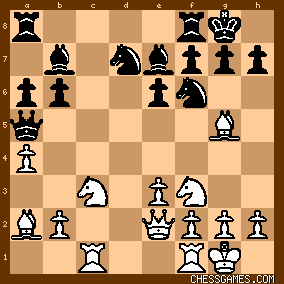
click for larger viewDespite a few questionable moves to this point, Bardeleben's position was not all that bad. But from here he began to get into trouble. 15. e4
The Tournament Book assigned this move a "!", but it was hardly best.Had Popiel exploited his chances here, Berdeleben could have faced difficulties. Best was 15. Bh5 15... Bb4
Missing 15...b5!
16. Bb1!
A nice try to regroup in a difficult situation. 16... Rac8
It is hard to decide whether this or 16...Rfc8 was better. 17. Bd2 Qh5
18. Rfe1
18. Rfd1 was probably better.
18... Nc5!
This left:
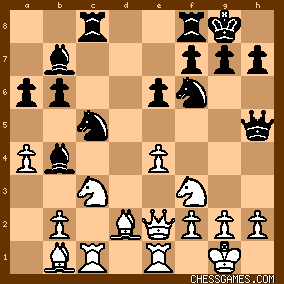
click for larger viewAs it turned out, and as I will attempt to show in my next post on this game, this was the crucial position in the game. Popiel perhaps enjoyed a small advantage here, but there was no reason for Bardeleben to despair. Until his next move, which proved fatal. |
|
Sep-01-18
 | | An Englishman: Good Evening: "Von upping his opponent?" Rather impressive how much use von Popiel got out of the back rank mate threats. |
|
Sep-01-18
 | | KEG: Post II
In the diagrammed position with which I ended my last post, Bardeleben erred badly with: 19. Na2?
After this lemon, the rest proved easy pickings for von Popiel. As will be seen shortly, Bardeleben's error allows the very sort of back rank mate threats aptly pointed out by <An Englishman> Bardeleben should have played 19. e5. The Tournament Book claimed this alternative would have been bad, but its evaluation was flawed. After 19. e5 BxN (f3), the Tournament Book is correct that Bardeleben would have been in big trouble had he then played 20. QxB since after 20...QxQ 21. gxQ Nb3 [but not the Tournament Book's 21...Nd7? since 22. Bc2 would then hold everything] 22. exN NxB leaves White with more threats than can be handled. But the Tournament Book overlooked that instead of 20. QxB in this line Bardeleben could have played the superficially ogly-looking 20. gxB giving White reasonable chances (e.g., 20...BxN 21. BxB Nd5 22. Rc4 Nb3 23. RxR RxR 24. Qxa6 Rd8 25. Qd3 with excellent chances of survival. After the text (19. Na2?), Bardeleben was finished, in large part because of the upcoming back-rank threats mentioned by <An Englishman>. In addition, of course, Bardeleben loses a pawn, though his problems prove far more severe than this material loss. 19... BxB
20. NxB QxQ
21. RxQ Nxa4
This left Bardeleben in the following unhappy position: 
click for larger viewDown a pawn and facing a myriad of threats and had no really good options. The best of a bad lot were either 22. RxR (23...RxR 24. b3 Nc5 25. f3) or 22. Nf1 RxR 23. NxR). But Bardeleben found something even worse: 22. Nc4
Now von Popiel rolled to victory, fueled in large part by those back-rank mate threats: 22... b5
23. Nd6
23. b3 was the only possible chance to offer resistance. 23... RxR+
24. NxR Rd8
This left:
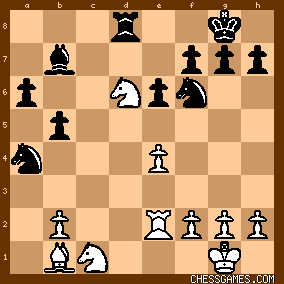
click for larger viewThe White Knight, needless to say, dare not move here because of the back-rank mate threat. 25. e5
25. Rd2 immediately was the other (hopeless) alternative. 25... Ne8
26. Rd2 NxN
27. RxN
The position now was:
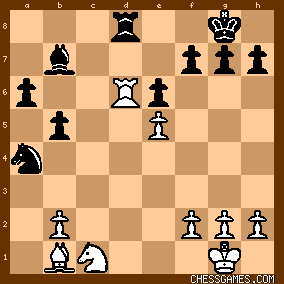
click for larger viewThe rest, as the saying goes and as I will discuss in my next post on this game, was just a matter of technique. |
|
Sep-01-18
 | | KEG: Post III
After 27. RxN, von Popiel could have won fairly simply with 27...RxR 28. exR Kf8. The move he chose, however, was also sufficient. 27... Rc8
28. Ne2
In light of the immediate mate threatened, the b2 pawn (and the game) is lost for White). If Bardeleben wanted to play on, 28. Nd3 (delaying but not avoiding the loss of the b2 pawn) offered the closest thing to resistance available. 28... Nxb2
29. Rb6 Rd8
Indirectly defending the b7 Bishop by the mating threat on d1. 30. Bc2?
Bardeleben is hopelessly lost anyway, but if he wanted to continue he should have eliminated the mating threats with 30. f4. 30... Be4
While this does the job, 30...Rd7! (threatening to win the White Rook with 31...Nc4) would have forced White to trade off Rooks with 31. Rd6 RxR 32. exR leaving von Popiel with a very easy win after 32...Kf8 31. Bb3?
Missing his last (slight) chance afforded by von Popiel's 30...Be4. Bardeleben should here have played 31. Rd6 and then after 31...RxR (forced) 32. exR Bc6 (forced) 33. Nd4 he would have at least had some counterplay. 31... Ra8
While the text hardly blows the win, 31...Bd3 was better and would have won easily (e.g., 32. Nd4 Kf8 33. Nc6 Rc8 34. f3 Na4 35. BxN bxB and White s helpless against Black's doubled a-pawns, 36. Nb4 Bb5 37. Nxa6 Bc4 38. Nb4 a3 39. Rb7 a2 40. Ra7 Rb8!). 32. f3
Bardeleben had apparently abandoned hope. After von Popiel's last move, he might have tried 32. f4 or perhaps 32. h4. 32... Bd3!
What followed was of little interest.
33. Nc1
33. Nd4 was better, but by this point it hardly mattered. 33... Bc4
34. f4 g5
This left:
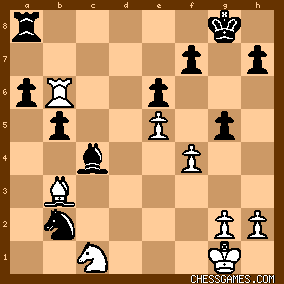
click for larger view35. g3
Bardeleben might as well have played 35. fxg5, though after 35...BxB 36. NxB Nd3 prospects would have remained bleak. After the text, things got truly ugly for Bardeleben. 35... gxf4
36. gxf4 BxB
37. NxB Nd3
This left:
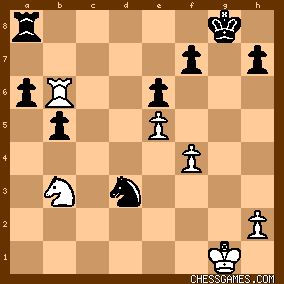
click for larger viewFaced with loss of yet another pawn, Bardeleben accepted the inevitable and: 0-1 |
|
|
|
|





